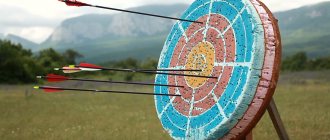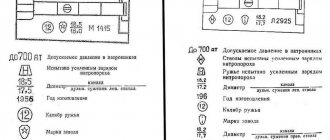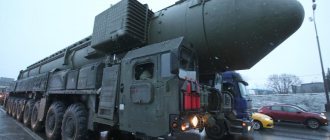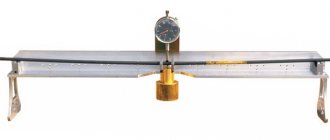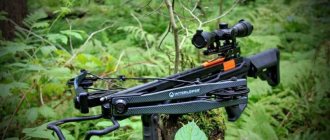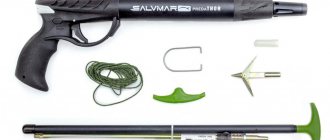The time has come to talk directly about the technique of shooting a crossbow. More precisely, about techniques. The options discussed below are for recreational and hunting applications. Fans of the practice of “survival” can safely equate the latter with their dear martial heart, the difference is not fundamental.
First, about the crossbows themselves. They can be very different both externally and “ideologically,” which is caused precisely by differences in the scope of application and shooting technique.
A little clarification for the authors of requests like “
Crossbow Crossbow ”. “Crossbow” translated from English actually means “Crossbow”. That is, if on the packaging and on the product itself there is only this word without a brand name, then we are talking about anonymous products from an equally anonymous manufacturer with the appropriate quality and shooting characteristics. Read more in the article “The whole truth about the Crossbow Crossbow and a little more about the names.”
How to calculate the range of an arrow
There is a difference between maximum sighting range and arrow range. Targeted shooting range indicators will be lower.
Contrary to popular belief, at a distance of 50 meters after the shot, the speed of the ejected arrow differs little from the initial one.
You can determine the speed and range of flight from a known time. The calculations are done as follows:
- The shot is fired upward (you need to slightly deviate the flight path so that the projectile does not return to the shooter’s head).
Formula for calculating speed. - The stopwatch measures the time from the shot to the fall.
- The resulting value is divided in half (since the take-off time will be equal to the fall time) and multiplied by 10 (or 9.8 m/s square - the acceleration of free fall).
For example, flight time is 8 seconds: 8/2x10=40. The flight speed is 40 m/s.
Calculations can be made based on other known values. Textbooks on ballistics will help with this. Before firing shots, you should make sure that there are no people or animals in the area.
Myth 9. The bow is worn at tension
Still from the movie “Tomb Raider: Lara Croft”
One more thing about transporting this wonderful weapon. In movies, heroes usually attach a bow to their body. At the same time, its handle and shoulders stick out behind the character’s back, and the bowstring touches the chest.
However, in reality, no one, absolutely no one, carries a weapon like that. Firstly, it is simply inconvenient and can damage the bowstring. Secondly, if the latter accidentally bursts, you will get a very painful lash across the face. And finally, the bowstring, when stretched, gradually History of archery: how medieval arrows were transported / Bow International weakens and the bow becomes unusable.
So most of the time the weapon traveled without a bowstring - it was attached immediately before the battle.
And they didn’t put bows over their heads. Only occasionally they were hung on the shoulder
. But usually longbows were carried by GF Asbell. The Traditional Bowyer's Bible in the hand, and short ones - like, for example, among horse nomads - were transported in a special case called a saydak or naluch.
Which arrows fly long distances?
Not all shells are suitable for long-distance shooting:
- The rod must be light enough but strong, otherwise when fired it will simply bend and not reach the target.
Requirements for arrows. - The weight of the tip must match the weight of the shaft. The arrow needs to be balanced.
- Minimum pen length and width required. This will reduce the drag force and increase speed.
- The plumage should be straight. The propeller reduces the speed and flight range.
From a crossbow
When shooting from a crossbow, the arrow experiences a greater load than when shooting from a bow. This is why crossbow bolts are thicker and heavier. Flight speed can be slightly increased by reducing weight. This must be done with caution, because projectiles that are too light can cause the same damage to the crossbow as a blank shot.
Compound crossbow.
From a bow
Compound bow shooting.
Bow arrows are thinner and lighter than crossbow bolts and have good flexibility. At the moment of shooting they bend, but after a few moments they return to their original shape. This factor also affects the firing range and accuracy. Well-balanced, high-quality arrows fired from a bow are not inferior in flight range to crossbow ones.
To ensure long-distance flight, the tension force should be 17-18 kg. Recurve bows shoot further than traditional bows.
Frequently asked questions and answers about bows and crossbows
Question: How much does a crossbow cost on average?
Answer: What is the average temperature in the hospital? The answer is 36.6. That is, what you need can cost 160 Euros, or maybe 2000, it all depends on what exactly you need. Try to understand for what purposes do you need a crossbow (bow) - hunting, sports, entertainment, commercial shooting? Estimate an approximate budget that you don’t mind for this matter, and we will be happy to recommend the best option, the option that is right for you.
Question: What is the destructive power of crossbows (bows)?
Answer: Lethal force on a hamster, elk or elephant? The lethal force on a hamster is enormous - 300 hamsters per hour, on an elephant - small, about half an elephant per day. That is, when talking about lethal force, you need to understand that there are a lot of factors: arrow speed, arrow weight, tip, shot distance and, in fact, the victim itself (weight, size, etc.). For example, for a bird such as a pheasant, an ordinary light arrow with a sharp tip and an arrow speed of about 30-40 meters per second is sufficient; for a wild boar weighing 100-150 kg, a heavy arrow with a three-bladed tip and a speed of about 70-90 meters per second are needed.
Question: What is the power of a crossbow (bow)?
Answer: In kilowatts or megatons? Power is a relative concept, just like “expensive” and “cheap”. For different bows and crossbows, there are the following parameters: the tension force of the arms, the length of the working stroke of the bowstring, the initial speed of the arrow (the weight of the arrow is indicated). In order to understand the effectiveness of a bow or crossbow for solving a specific task, you need to know all the parameters of the product, including your own. Because not everyone can string a 70 pound bow...
Question: What is the range of a direct shot?
Answer: There is practically no direct shot for crossbows and bows. If for a bullet flying at a speed of 600-900 meters per second we can conditionally talk about a direct shot, then for an arrow flying at a speed of 80-100 meters per second this is impossible. An arrow always has a rather steep trajectory (compared to a bullet), and the fun of shooting is to understand this trajectory and be able to make the correct takeoff. We often talk not about a direct shot, but about the effective shooting distance, that is, the distance at which you can confidently hit the target, and more than once: Since there are a great many bows and crossbows, the effective shooting distance can range from 10 meters to 100 meters. The maximum range of the shot will be provided by a firing angle of 45 degrees, but the “sighting” will be relative...
Question: What is the maximum firing range?
Answer: The maximum range of a shot depends on the initial speed of the arrow, its weight, fletching and tip shape. With the best combination of all factors, the arrow flies several hundred meters, sometimes up to half a kilometer.
Question: How to zero a crossbow?
Answer: Shooting crossbows and bows is a purely individual matter, since each shooter has unique anthropometric data. We can roughly zero a crossbow or bow for a certain distance, but the final zero is your concern. Start with the minimum shooting distance, gradually increasing the distance to the target until you achieve the desired result. The main goal of zeroing is to adjust the sight so that you understand at what distance the arrow will be at what point. Keep in mind that if you shoot a crossbow (bow) with one type of arrow, you will have a different result when using a different type of arrow. There are many types of arrows and they all fly differently - this must be clearly understood.
By the way, there are arrows with replaceable tips, which also play an important role in the aerodynamics of the arrow. Tips can be light or heavy, two, three or more bladed, and each will change the trajectory of the arrow in its own way. Therefore, try to use one type of arrowhead and shoot arrows with it, so as not to regret later about lost arrows and runaway boars.
Do not forget to securely fix all elements of the sighting mechanism so that no parts of it dangle or move, otherwise you will have to shoot again. For screw and threaded connections of the sight rail and scope brackets, use a locking agent such as Lock Tight or Threadlock Formula - it helps a lot.
Question: What are the shoulders made of?
Answer: Bows, or more correctly, the arms of modern crossbows, are made from a variety of materials: steel, aluminum, fiberglass laminate, composite materials, carbon. The best-proven shoulders are made of composite, which is a multilayer structure of fiberglass and carbon.
The fiberglass structure of the shoulders gives them high energy intensity, and carbon fiber has reinforcing properties. The shape of the shoulders, depending on the purpose, can be either straight or recursive, that is, with a characteristic bow-shaped bend. At their ends, crossbow arms have so-called “tips” - seats for the bowstring. The big advantage of the latest generation of shoulders is their “fatigue resistance” - the shoulders will retain the stability of their characteristics even after several thousand shots.
Question: What is the stock made of?
Answers: The main materials for making stocks are now either natural wood materials: beech, walnut, mahogany, rosewood, or molded plastics. Wood looks better due to its natural beauty, and plastic is more practical and is not afraid of atmospheric influences.
Question: What is the crossbow body made of?
Answer: The body of modern crossbows is very different from their ancient counterparts. In modern crossbows, the body is mostly made of steel or light alloys. A guide is installed on top of the body. It is covered with friction-resistant materials such as getinax, fluoroplastic or coprolone. The bowstring and arrow slide along it.
Question: What is the trigger mechanism made of?
Answer: The locks or triggers of modern crossbows are made using precision equipment from high-strength metal - most often weapon steel. Such locks can withstand enormous loads and are practically resistant to wear. The designs of the locks themselves differ from different manufacturers - from simple, elementary ones, similar in design to medieval walnut-type locks, to complex sports ones, with adjustable release force. Expensive match crossbows often use electronic release locks that are triggered by a light touch of a finger.
Question: Weapons or not weapons?
Answer: Hunting with a bow and crossbow is rather exotic for those who have already tried everything and want to master a new type of hunting, complicate the task and find themselves on equal terms with the animal.
I ask you to clear your head of fables, gossip and stupid stories about bows and crossbows, because most of them were invented by amateurs who know nothing about this topic. The problem is that with a lack of information, people live by rumors and speculation that have little to do with reality.
Well, what is reality like? The truth is that the crossbow and bow, contrary to all rumors, will never be able to compete with firearms, be a means of poaching or a weapon of hired killers with rare exceptions. In movies, we sometimes see killers sneaking through dark streets with a crossbow on their shoulder, however, in practice, a crossbow is a completely inconvenient tool for hackers.
Firstly, the crossbow has large dimensions - it is physically very difficult to hide, since its powerful shoulders have a span of more than half a meter and a stock about a meter long. Assembling and disassembling a crossbow takes time...
Secondly, the crossbow is single-shot, and reloading it most often requires at least 10 seconds. An automatic rifle can fire five or six bullets in one second.
Thirdly, the energy of a crossbow or bow cannot even be compared with the energy of a bullet; it is orders of magnitude less. It is simply impossible to guarantee the “lethality of a shot.”
Fourthly, the arrow's flight speed is a maximum of 110-120 m/sec, which means it is impossible to shoot at a moving target - the probability of a hit is sharply reduced.
And one more, most important argument - the flight trajectory of an arrow (unlike a bullet) is quite steep and strongly depends on the position of the shooter, wind strength, the tip and feathering of the arrow, the diameter and material of the tube, the tension force of the arms and many other factors arrows that need to be taken into account. It is believed that the crossbow fires silently. It's a delusion. The sound strength of the bowstring of a powerful crossbow is comparable to a shot from a small-caliber rifle, and unlike a rifle, you cannot put a silencer on a crossbow...
In general, taking into account all the arguments, we can summarize - a crossbow or a bow is exotic, which is not acceptable for assassins.
By the way, the statistics of hired murders across the country over the past five years confirms my words - only isolated murders took place with the help of throwing weapons... Apparently in those cases the killer either had a very “creative” customer, or the murder was of a ritual nature. And judge for yourself - is a rapid-fire automatic large-caliber rifle with a silencer and powerful optics, capable of “solving problems” at a distance of up to a kilometer, really comparable to a crossbow, which is really effective at a distance of 50-60 meters? Of course no! Besides, learning how to shoot a crossbow well takes a lot of time and practice...
Everything that has been said about the crossbow also applies to the bow, only in cube. A bow, no matter how modern it is, is a complex weapon that requires regular training and an experienced mentor. It usually takes months of practice and ongoing master classes to master basic archery skills. As for hunting and poaching, the use of bows and crossbows is possible, but very difficult under certain circumstances.
Firstly, the hunter must get as close as possible to the victim, literally a few tens of meters, in order to confidently hit the target.
Secondly, again, energy... An arrow, unlike a bullet, does not cause a powerful hydrodynamic effect and does not hit on the spot. The hunting tip mortally wounds the victim due to its cutting effect. The hunter often has to pursue the animal as it was in ancient times.
Thirdly, again, the single-shot nature and steepness of the arrow’s flight path, which complicate the hunting process. Hunting with a bow and crossbow is rather exotic for those who have already tried everything and want to master a new type of hunting, complicate the task and find themselves on equal terms with the animal. This is a hunt for arrow fans, true masters of camouflage and, of course, noble people. There is another argument. Hunting with throwing weapons is not for poor people. The cost of a shot, and especially a miss, is the cost of an arrow and it ranges from 6 to 20 dollars... Only wealthy people, for whom poaching is not a means of survival or a way to earn money, can afford such a low-budget type of hunting...
Thus, looking at all the objective features of the use of bows and crossbows, it can be argued that throwing weapons are the lot of professional athletes and hunters who respect nature and do not perceive hunting as a trade. I do not rule out the possibility that “someone here and there sometimes” poaches with throwing weapons, but these episodes can safely be considered a rare exception.
There are practical examples. Look at the game industry of the USA and Canada, where several million archers and crossbowmen live. Wonderful balanced hunting laws, mini-seasons for hunting with projectile weapons and the result - a huge population of white-tailed deer - the main prey for archery shooters. The Russian ban on powerful bows and bow hunting is the same absurdity as cutting down vineyards or destroying poisonous snakes, supposedly they can bite...
We can only envy the wisdom of American legislators and hope that the ban on hunting with throwing weapons will be lifted, and people will have the opportunity to realize their ancient instincts at the most modern level.
Question: How to choose a bow for a teenager?
Answer: To begin with, it is better to buy the simplest possible recurve bow, reliable and easy to learn, but youthful, that is, of reduced size, weight and tension.
Bob Mizek, an archery coach, shares his experience, because he got his two sons interested in archery, and they still compete in competitions. Draw Weight: Mizek admits there are two types of bows for youth. The first are entry-level models, for children about 10 years old, a draw weight of 15-20 pounds (7-9 kg) is enough for them. These bows should be as light and short as possible, since it is difficult for children to hold a bow heavier than 1-4 pounds (up to 1 kg). But these are just toys.
The second are bows for more experienced archers, or for teenagers 14-15 years old, Mizek recommends a draw weight in the 25-45 lb (11-20 kg) range. Bows of 50 pounds (22 kg) and stronger are only suitable for physically developed teenagers, usually boys, 14-15 years old. Bow Draw Length: The perfect bow will grow with your child. It must have a modular design or adjustable length of pull over a very wide range. This will help the parent who needs to adjust the bow according to the teenager's body height.
Bow weight. The bow should be light enough that the young archer can hold it without fatigue or trembling, most likely a bow weighing about a kilogram or a little more. Block spacing: 30-35 inches (76-89 cm) is preferred, depending on the height of the archer. Handle size: small handle, suitable for teenagers. If the handle is comfortable for you, it means it is too big for a teenager.
Question: Where are modern crossbows used? What are their characteristics?
Answer: From the moment the first person who had a grudge against his neighbor picked up a gnarled stick, human thought, with a tenacity worthy of better use, has been developing ways to beat his neighbor from the greatest possible distance. The club made it possible to do this from one and a half to two meters, the spear - from two to three. The sling increased the distance to 40-50 m, the bow - to more than 100-150. The significant disadvantages of the bow were its dimensions and the inability to keep the weapon cocked with an arrow on the string all the time. The crossbow almost tripled the strike distance at once and, moreover, could remain cocked for a long time without significant damage to shooting accuracy. It should not be forgotten that the bow arrow was, as a rule, wooden and had a relatively small mass. And the mass of a European crossbow bolt reached 400 grams. And it was made of iron. Such a “flying crowbar” hit with such force that the question of hitting, for example, a visor slot, was removed by itself.
But all this is in the past. What now? You can purchase a crossbow or bow to your liking in almost any weapons store (Moscow). You can easily buy a schnapper crossbow, a Black Python crossbow, a Cheetah crossbow, a Tarantula crossbow, and an Asp crossbow. A serious, reputable store must have at least two or three models on sale. The most common crossbows we see are Western-made, “Bear”, “Devastator”. Appearance - at the level: duralumin, plastic, varnish; diopter or optical sight; the original cocking system - not only with a “goat leg” but also by breaking the butt (which strangely resembles an ordinary double-barreled shotgun). Sometimes, however, you come across serious machines - for example, - at one glance at which you understood that a weapon can be not only powerful, but also beautiful... Such wonderful gifts as a crossbow or a bow will always be appreciated. As for combat qualities, a modern crossbow is in no way inferior to its firearms rivals.
You can also buy onions without any problems. The gun store will offer you sporting bows, any compound bow, arrows and accessories.
Question: To hunt or not?
Answer: Hunting with a bow or crossbow in our time is quite an elite pastime. Besides the fact that this type of hunting is not allowed everywhere (in our country, for example, it is prohibited), it is also quite expensive. In addition, only a few shooters risk using a hunting crossbow against a serious animal - as a rule, backup is required. And yet, such hunts are widespread in the West - mainly in the USA, much less in Europe.
Question: What about crossbow sports?
Answer: Suddenly, crossbow shooting has become an extremely popular sport. I would like to note with satisfaction that here we have not lost face. Back in the USSR, crossbow shooting was well developed in the Baltic states and Moscow. Several times championships in this sport were even held in Moscow. True, it is quite difficult to recognize in it a competition of shooters, so carefully described by Conan Doyle in the famous “White Company”. No one is trying to launch a bolt 400 meters or quickly hit a flying bird with two arrows. The competitions have become significantly less bloodthirsty, but have not lost their entertainment value.
Now all crossbows are divided into three categories, and assignment to one or another category depends on the amount of force required to pull the bowstring.
Crossbows with a cocking force of up to 43 kg are considered light (although their weight can reach several kilograms).
From 43 to 110 kg - medium crossbow. The majority of imported crossbows sold in our gun stores belong to this class.
And finally, over 110 kg - a heavy crossbow. Moreover, it is really heavy - it weighs more than 10 kg!
Optical sights are not installed on sporting crossbows, and folding or folding stocks are also not used. On light crossbows, the bowstring is tensioned manually, on others - with a goat's foot. There are no fixed high-speed reloading mechanisms or magazine devices for arrows - the same applies to carrying belts.
The shooting rules have also changed significantly. It is now conducted at several main distances and is divided into indoor and outdoor shooting. Indoors they shoot at 18 and 36 meters. At the shooting range, a distance of 50 meters is added. Shooting is carried out in series of three shots at three targets mounted on one shield. It should be taken into account that the size of the “ten” on the target for 18 and 36-meter distances is slightly larger than a five-kopeck coin.
The conditions for competitions in heavy crossbow shooting are quite unusual. Despite the solid dimensions and weight of the weapon, the firing distance is only... 10 meters. True, the target used is small, 10 cm. It is made from lead. “Ten” is about a penny. Although the arrows of heavy crossbows are quite thick (10-12 mm), their tip is thin and sharp, with a diameter of only about a millimeter. The winner is determined by the number of hits in the top ten.
Light and heavy crossbows are intended exclusively for sport shooting. But a middle-class crossbow can be sporting, hunting, or combat
The ancient device has successfully survived to this day and continues to develop successfully. The history of the crossbow has not yet been fully written.
Ancient archers: their achievements
Bows were invented back in ancient times. Judging by the finds of archaeologists, this type of small arms appeared at approximately the same time in China and Greece.
Historical finds confirm that bows and crossbows were widely used in the countries of Asia and Europe, in the territory of Ancient Rus'.
During the Middle Ages, weapons were constantly improved. For their manufacture, hardwood, metal, tendons and animal horn tissue were used.
Documented records of antiquity:
- games in Chersonesos in the 3rd century BC. The archer Anaxagoras fired his bow at a distance of 534 meters;
- in the Mongolian official chronicles, a record for the flight range of an arrow of approximately 400 meters was recorded, made by Khan Kulkan, the son of Genghis Khan;
- Turkish Sultan Murat Ghazi achieved a result of 878 meters;
- in 1795 in London, the secretary of the Turkish embassy fired at a distance of 442 meters.
The initial speed of arrow flight varied among different peoples:
- English and Chinese bows – up to 70 m/s;
- high-quality Japanese devices and Indian bows - 55-70 m/s;
- pygmy bows – 25-40 m/s (modern children’s bows have the same speed);
- Turkish guns - from 70 to 100 m/s.
It is known that ancient craftsmen made bows and crossbows that were not much inferior in firing range to modern products.
Determining the required diameter
Diameter, as a characteristic of a projectile, depends on the purpose of use. The question often arises about what arrows are needed for weapons. If a sport is being considered, then a projectile with a wider diameter is chosen, since it is more likely to accurately fly to a round target.
But competitions have strict rules that you must familiarize yourself with before they take place. In the case of hunting, thin products are used because they are less susceptible to the influence of wind and also penetrate deeper into the selected target.
How to speed up your flight
Conditions necessary to achieve maximum flight of an arrow or bolt:
- the time of influence of the bowstring on the arrow should be longer;
Quiver and arrows. - maximum buoyancy force;
- the mass of the projectile and moving parts of the device should be as small as possible.
Thus, in order to increase efficiency and speed up flight, you need to strengthen the arcs or increase the length of the bowstring.
Arm span to arrow length ratio
| Arm span (cm) | 155 | 160 | 165 | 170 | 175 | 180 | 185 | 190 | 195 |
| Boom length (cm) | 58 | 61 | 63 | 64,5 | 66 | 68 | 69,5 | 71,5 | 73 |
The table shows average parameters. For a more accurate determination, it is better to install the longest product first. It is necessary to make a cut-off on the “barrel” of the projectile right at the point where the tip will be located in the future.
This cutoff is set during the full natural tension of the bowstring. Your coach makes a cut before the point where the projectile touches the shelf. The gap between the point of contact and the cutoff is about 16 mm if you are an experienced athlete, and 21-40 mm for beginners. The entire procedure will take approximately an hour.
Safety rules for air rifle and bow shooting
A novice shooter who wants to learn how to shoot accurately from a crossbow, bow or any other type of weapon must follow safety rules when shooting. Only after familiarizing yourself with the safety rules and agreeing to comply with them, a person is allowed to study shooting techniques.
Before starting shooting, the student must listen to instructions from the master regarding safety rules. You need to enter the hall where training is taking place slowly, in a calm and balanced emotional state; if the shooter has some vision problems, you will need to wear glasses.



